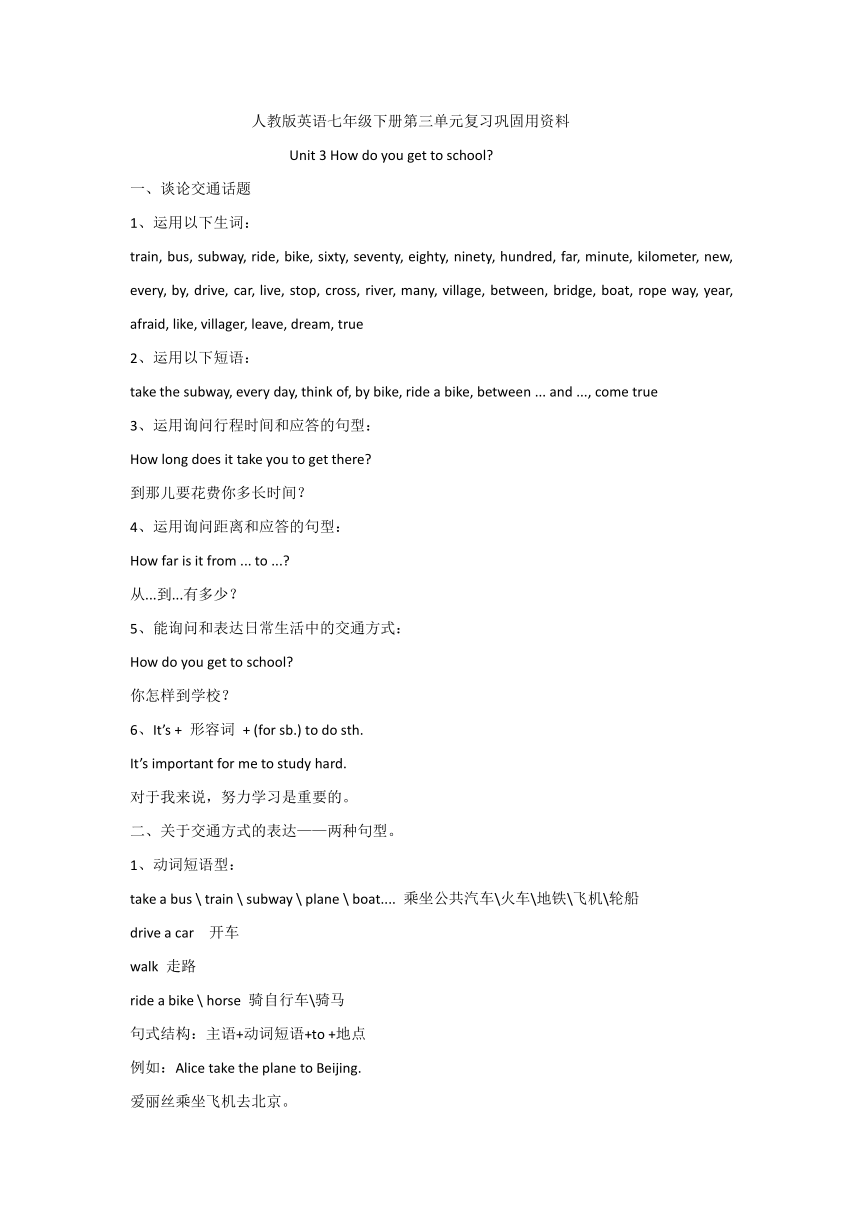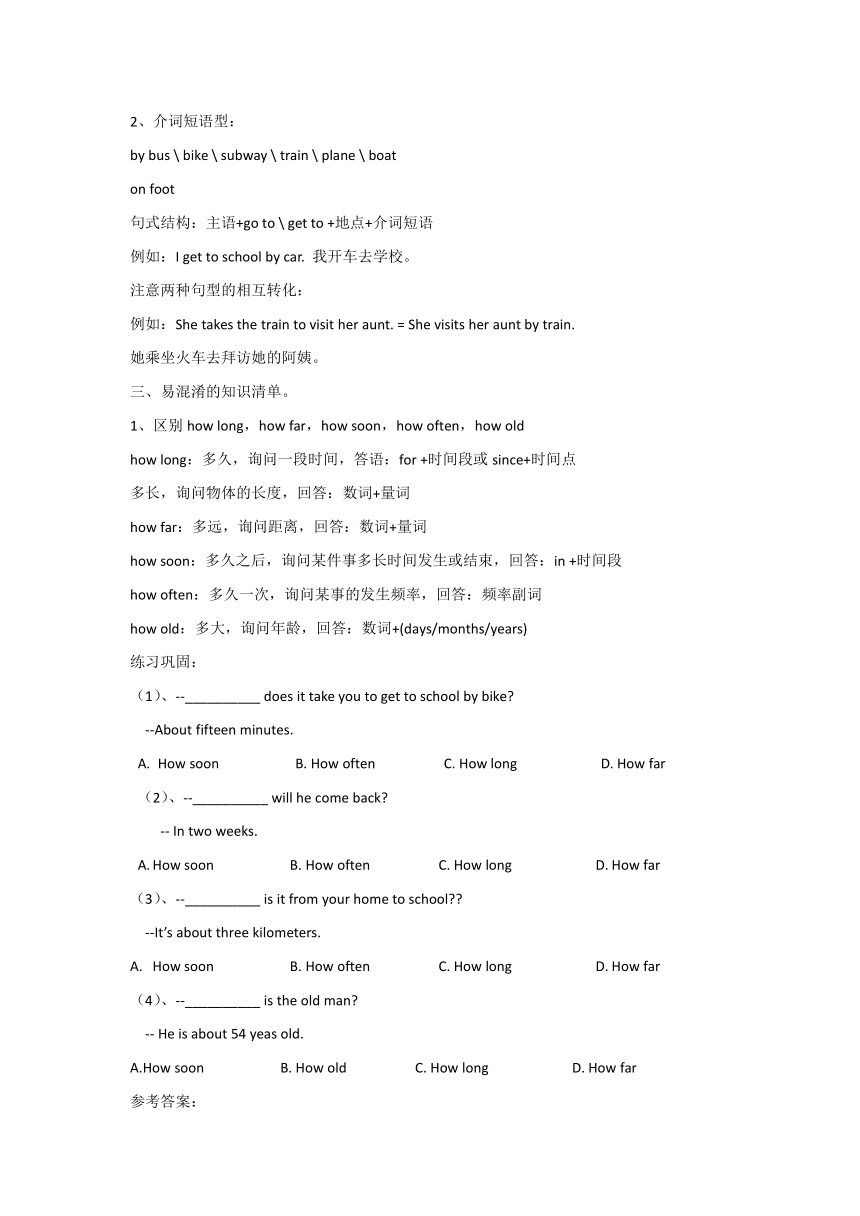人教新目标(Go for it)版七年级下册Unit 3 How do you get to school?复习巩固用资料及练习(含答案)
文档属性
| 名称 | 人教新目标(Go for it)版七年级下册Unit 3 How do you get to school?复习巩固用资料及练习(含答案) |

|
|
| 格式 | docx | ||
| 文件大小 | 15.6KB | ||
| 资源类型 | 教案 | ||
| 版本资源 | 人教新目标(Go for it)版 | ||
| 科目 | 英语 | ||
| 更新时间 | 2024-06-14 17:16:47 | ||
图片预览


文档简介
人教版英语七年级下册第三单元复习巩固用资料
Unit 3 How do you get to school
谈论交通话题
1、运用以下生词:
train, bus, subway, ride, bike, sixty, seventy, eighty, ninety, hundred, far, minute, kilometer, new, every, by, drive, car, live, stop, cross, river, many, village, between, bridge, boat, rope way, year, afraid, like, villager, leave, dream, true
2、运用以下短语:
take the subway, every day, think of, by bike, ride a bike, between ... and ..., come true
3、运用询问行程时间和应答的句型:
How long does it take you to get there
到那儿要花费你多长时间?
运用询问距离和应答的句型:
How far is it from ... to ...
从...到...有多少?
能询问和表达日常生活中的交通方式:
How do you get to school
你怎样到学校?
It’s + 形容词 + (for sb.) to do sth.
It’s important for me to study hard.
对于我来说,努力学习是重要的。
关于交通方式的表达——两种句型。
动词短语型:
take a bus \ train \ subway \ plane \ boat.... 乘坐公共汽车\火车\地铁\飞机\轮船
drive a car 开车
walk 走路
ride a bike \ horse 骑自行车\骑马
句式结构:主语+动词短语+to +地点
例如:Alice take the plane to Beijing.
爱丽丝乘坐飞机去北京。
介词短语型:
by bus \ bike \ subway \ train \ plane \ boat
on foot
句式结构:主语+go to \ get to +地点+介词短语
例如:I get to school by car. 我开车去学校。
注意两种句型的相互转化:
例如:She takes the train to visit her aunt. = She visits her aunt by train.
她乘坐火车去拜访她的阿姨。
易混淆的知识清单。
区别how long,how far,how soon,how often,how old
how long:多久,询问一段时间,答语:for +时间段或since+时间点
多长,询问物体的长度,回答:数词+量词
how far:多远,询问距离,回答:数词+量词
how soon:多久之后,询问某件事多长时间发生或结束,回答:in +时间段
how often:多久一次,询问某事的发生频率,回答:频率副词
how old:多大,询问年龄,回答:数词+(days/months/years)
练习巩固:
(1)、--__________ does it take you to get to school by bike
--About fifteen minutes.
How soon B. How often C. How long D. How far
(2)、--__________ will he come back
-- In two weeks.
How soon B. How often C. How long D. How far
(3)、--__________ is it from your home to school
--It’s about three kilometers.
How soon B. How often C. How long D. How far
(4)、--__________ is the old man
-- He is about 54 yeas old.
A.How soon B. How old C. How long D. How far
参考答案:
、C (2)、A (3)、D (4)、B
stop的用法
stop做名词,意思是“车站”,例如:bus stop汽车站
stop作动词,意思是“停止”,有三种用法:
stop to do sth. 停下来做某事(强调停下来去做另一事情)
stop doing sth. 停止做某事(强调停止正在做的事情)
stop sb./sth. from doing sth. 阻止某人/某物做某事
例如:Please stop ______ and go out for a walk. Remember ______ warm clothes
A. to study; wearing B. studying; to wear
C. to study; to wear D. studying; wearing
参考答案:B
区别cross , across , through , over
Cross,v. 穿过、越过、度过,cross the street/the river 穿过街道/河流
Across,prep. 从一边到另一边,横过(常与walk, go, fly, jump, run等连用),例如:He walked across the street.=He crossed the street. 他穿过街道。
又如:Where is the nearest bridge across the river 过河最近的桥在哪?
Through,prep. 从一端到另一端,穿过,贯穿(常常指穿过森林、窗户等),例如:The sand ran through my fingers. 沙子从我的手指缝间漏了下去。
又如:The path led through the trees to the river. 这条小河穿过树林通向河边。
Over,prep. 越过(常指横跨、翻过、越过),例如:He climbed over the wall. 他翻墙过去。
区别between和among
There is a very big river between their school and their village.
他们的学校和村庄之间有一条非常大的河。
Between “在......之间”,强调两者之间,常用短语between ... and ...(在......和......之间)
Among “在......之间”,强调三者或三者以上之间。
例如:The high-speed train ______ Qiangdao and Beijing travels faster now. The train ride takes only about three hours.
from B. among C. in D. between
参考答案:D
区别same与different
same相同的,形容词,前面一般要带上the,构成the same as...,表示“与...一样”。例如:His hair cut is the same as the famous actor. 他的发型跟那个著名的演员一样。
different不同的,形容词,常用短语:be different from... ,表示“与...不同”,例如:The weather here is different from there in my hometown. 这儿的天气与我家乡的天气不一样。
Unit 3 How do you get to school
谈论交通话题
1、运用以下生词:
train, bus, subway, ride, bike, sixty, seventy, eighty, ninety, hundred, far, minute, kilometer, new, every, by, drive, car, live, stop, cross, river, many, village, between, bridge, boat, rope way, year, afraid, like, villager, leave, dream, true
2、运用以下短语:
take the subway, every day, think of, by bike, ride a bike, between ... and ..., come true
3、运用询问行程时间和应答的句型:
How long does it take you to get there
到那儿要花费你多长时间?
运用询问距离和应答的句型:
How far is it from ... to ...
从...到...有多少?
能询问和表达日常生活中的交通方式:
How do you get to school
你怎样到学校?
It’s + 形容词 + (for sb.) to do sth.
It’s important for me to study hard.
对于我来说,努力学习是重要的。
关于交通方式的表达——两种句型。
动词短语型:
take a bus \ train \ subway \ plane \ boat.... 乘坐公共汽车\火车\地铁\飞机\轮船
drive a car 开车
walk 走路
ride a bike \ horse 骑自行车\骑马
句式结构:主语+动词短语+to +地点
例如:Alice take the plane to Beijing.
爱丽丝乘坐飞机去北京。
介词短语型:
by bus \ bike \ subway \ train \ plane \ boat
on foot
句式结构:主语+go to \ get to +地点+介词短语
例如:I get to school by car. 我开车去学校。
注意两种句型的相互转化:
例如:She takes the train to visit her aunt. = She visits her aunt by train.
她乘坐火车去拜访她的阿姨。
易混淆的知识清单。
区别how long,how far,how soon,how often,how old
how long:多久,询问一段时间,答语:for +时间段或since+时间点
多长,询问物体的长度,回答:数词+量词
how far:多远,询问距离,回答:数词+量词
how soon:多久之后,询问某件事多长时间发生或结束,回答:in +时间段
how often:多久一次,询问某事的发生频率,回答:频率副词
how old:多大,询问年龄,回答:数词+(days/months/years)
练习巩固:
(1)、--__________ does it take you to get to school by bike
--About fifteen minutes.
How soon B. How often C. How long D. How far
(2)、--__________ will he come back
-- In two weeks.
How soon B. How often C. How long D. How far
(3)、--__________ is it from your home to school
--It’s about three kilometers.
How soon B. How often C. How long D. How far
(4)、--__________ is the old man
-- He is about 54 yeas old.
A.How soon B. How old C. How long D. How far
参考答案:
、C (2)、A (3)、D (4)、B
stop的用法
stop做名词,意思是“车站”,例如:bus stop汽车站
stop作动词,意思是“停止”,有三种用法:
stop to do sth. 停下来做某事(强调停下来去做另一事情)
stop doing sth. 停止做某事(强调停止正在做的事情)
stop sb./sth. from doing sth. 阻止某人/某物做某事
例如:Please stop ______ and go out for a walk. Remember ______ warm clothes
A. to study; wearing B. studying; to wear
C. to study; to wear D. studying; wearing
参考答案:B
区别cross , across , through , over
Cross,v. 穿过、越过、度过,cross the street/the river 穿过街道/河流
Across,prep. 从一边到另一边,横过(常与walk, go, fly, jump, run等连用),例如:He walked across the street.=He crossed the street. 他穿过街道。
又如:Where is the nearest bridge across the river 过河最近的桥在哪?
Through,prep. 从一端到另一端,穿过,贯穿(常常指穿过森林、窗户等),例如:The sand ran through my fingers. 沙子从我的手指缝间漏了下去。
又如:The path led through the trees to the river. 这条小河穿过树林通向河边。
Over,prep. 越过(常指横跨、翻过、越过),例如:He climbed over the wall. 他翻墙过去。
区别between和among
There is a very big river between their school and their village.
他们的学校和村庄之间有一条非常大的河。
Between “在......之间”,强调两者之间,常用短语between ... and ...(在......和......之间)
Among “在......之间”,强调三者或三者以上之间。
例如:The high-speed train ______ Qiangdao and Beijing travels faster now. The train ride takes only about three hours.
from B. among C. in D. between
参考答案:D
区别same与different
same相同的,形容词,前面一般要带上the,构成the same as...,表示“与...一样”。例如:His hair cut is the same as the famous actor. 他的发型跟那个著名的演员一样。
different不同的,形容词,常用短语:be different from... ,表示“与...不同”,例如:The weather here is different from there in my hometown. 这儿的天气与我家乡的天气不一样。
同课章节目录
- Unit 1 Can you play the guitar?
- Section A
- Section B
- Unit 2 What time do you go to school?
- Section A
- Section B
- Unit 3 How do you get to school?
- Section A
- Section B
- Unit 4 Don't eat in class.
- Section A
- Section B
- Unit 5 Why do you like pandas?
- Section A
- Section B
- Unit 6 I'm watching TV.
- Section A
- Section B
- Review of Units 1-6
- Unit 7 It's raining!
- Section A
- Section B
- Unit 8 Is there a post office near here?
- Section A
- Section B
- Unit 9 What does he look like?
- Section A
- Section B
- Unit 10 I'd like some noodles.
- Section A
- Section B
- Unit 11 How was your school trip?
- Section A
- Section B
- Unit 12 What did you do last weekend?
- Section A
- Section B
